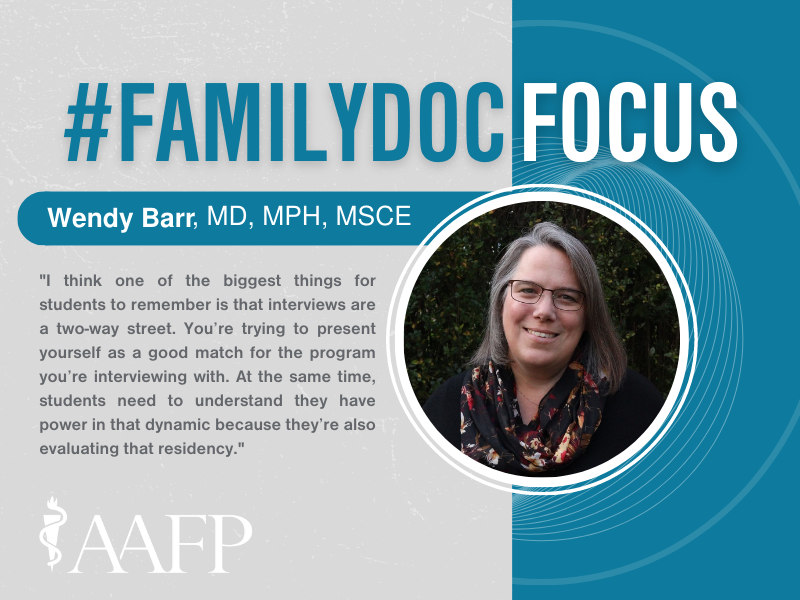National Conference Speaker Eager to Help Students Match
July 20, 2023, David Mitchell — Thousands of medical students will gather July 27-29 in Kansas City, Mo., bringing with them numerous questions about applying to family medicine residencies and nailing their interviews.

Wendy Barr, M.D., M.P.H., M.S.C.E., will be there, as usual, to help attendees find the answers during the National Conference of Family Medicine Residents and Medical Students.
Barr, who was the residency program director of the Greater Lawrence Family Health Center in Lawrence, Mass., from 2015-22, will once again moderate a popular panel discussion regarding residency applications. Changes to the Electronic Residency Application Service, including the introduction of program signaling, are likely to be part of that discussion.
“Every year I say, ‘The application process is changing a lot,’” said Barr, past president of the Association of Family Medicine Residency Directors. “I keep thinking it’s going to stop changing, but it doesn’t seem like that’s going to happen. The ERAS changes are significant. They add uncertainty into what is already a stressful process, so hearing from a panel of people who have read thousands of applications can help you understand what they might be looking for.”
Barr also has been presenting a session called the “Do’s and Don’ts of Interviewing” for years at National Conference with her Tufts University School of Medicine colleague Keith Nokes, M.D., M.P.H. This time around they’ll be joined by Camille Garrison, M.D., program director of North Side Milwaukee Health Centers Family Medicine Residency Program and associate professor at the Medical College of Wisconsin.
Barr said the interview is the most important part of the application process and finding the residency that fits you best.
“I think one of the biggest things for students to remember is that interviews are a two-way street,” she said. “You’re trying to present yourself as a good match for the program you’re interviewing with. At the same time, students need to understand they have power in that dynamic because they’re also evaluating that residency. It’s called the match for a reason. We’re all trying to figure out how we fit with each other. There is such diversity in family medicine, I think it’s to students’ benefit to try to be their authentic selves, because when you’re not, you don’t present your best self and you’re actually not going to get a good match.”
Though she’s no longer a program director or an AFMRD officer, Barr is still making an impact on family medicine training on the national level. She devotes about one-fourth of her time to the ABFM performing research related to training outcomes.
“We’re trying to provide information and tools for program directors, faculty and residents as we enter this world of new program requirements,” she said. “The new requirements give residents a lot more flexibility, but with that flexibility you need to figure out what works to make sure residents are ready for independent practice.”
Barr is the principal investigator on a project that has followed the family medicine class of 2018 to identify associations between what residents experienced during training and how they practice family medicine now.
Researchers surveyed program directors in 2018 through the project and linked the to data from the ABFM’s annual National Graduate Surveys to learn “what those physicians are doing, where they’re doing it and how much they’re doing it,” Barr said.
Initial findings were presented at the STFM Annual Meeting this year, and related papers are being drafted for publication, she said.
The work is also leading in new directions. Every family medicine resident takes the ABFM’s In-Training Exam each year to help them prepare for the ABFM Board exam. Barr is working with the ABFM researchteam to develop a survey to deploy with that exam.
“What are people experiencing in residency?” asked Barr.“We know about the experience right at the end of training from a survey that the ABFM does when peoplethe certification exam, and then they survey people periodically afterwards, including through the National Graduate Survey. This new survey will help us better understand the resident experience during residency.”
Barr hopes to pilot the survey this fall.
“If it works,” she said, “we’ll do it annually.”
Barr also is working to help expand the family medicine workforce in her new role as director of academic development for One Medical, which offers a membership-based primary care model.
One Medical started in San Francisco, where it has built a partnership with the University of California-San Francisco that includes working with medical, nursing and physician assistant students.
“One Medical is a national primary care organization that is partnered with UCSF Health in the Bay Area to provide seamless care, including being a family medicine clerkship site,” she said, “so that’s kind of a nice, robust model to start with to have medical students at One Medical. But as One Medical has grown into more markets, there have been challenges about how to get that going in those markets. The idea is to think about how to develop some standard processes that can be sustained and streamlined across the organization and create more opportunities for medical learners.”
Barr continues to practice a broad scope in the outpatient setting, including women’s health, pediatrics and procedures at One Medical’s Boston location adjacent to Massachusetts General Hospital.
“Students need to be open and understand that there are lots of different ways to practice primary care,” she said. “There are direct primary care practices. There are systems disrupters like One Medical, ChenMed or Oak Street Health. Students should be encouraged to go into primary care. It’s an exciting time to engage. I encourage students to really think about the breadth of what they can do in family medicine and the impact they can have because we know that more primary care is associated with healthier communities and people living longer.”